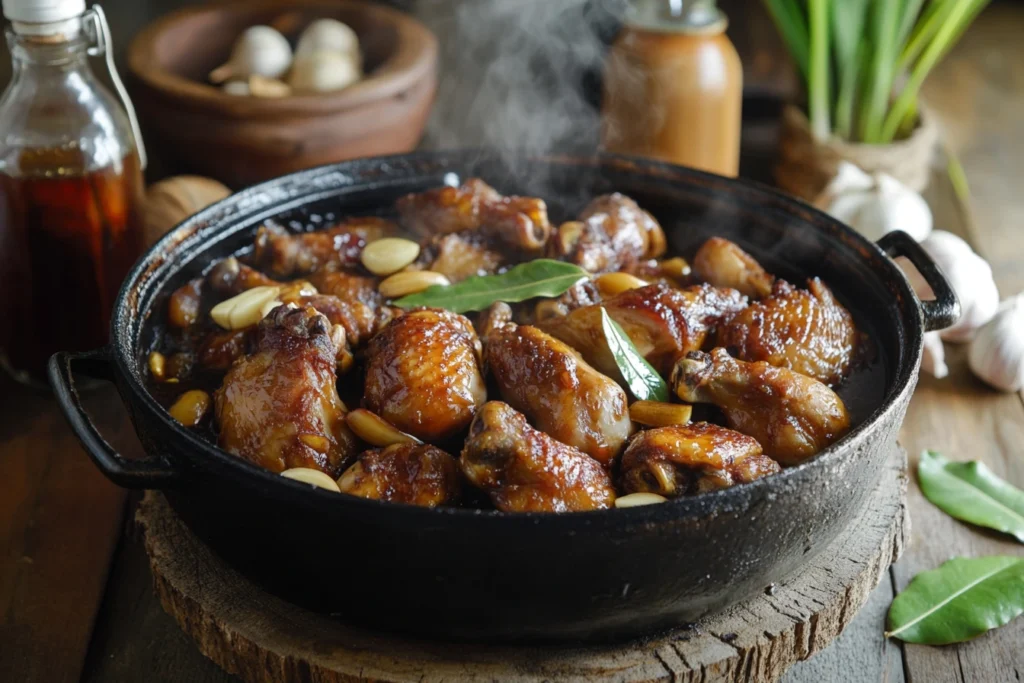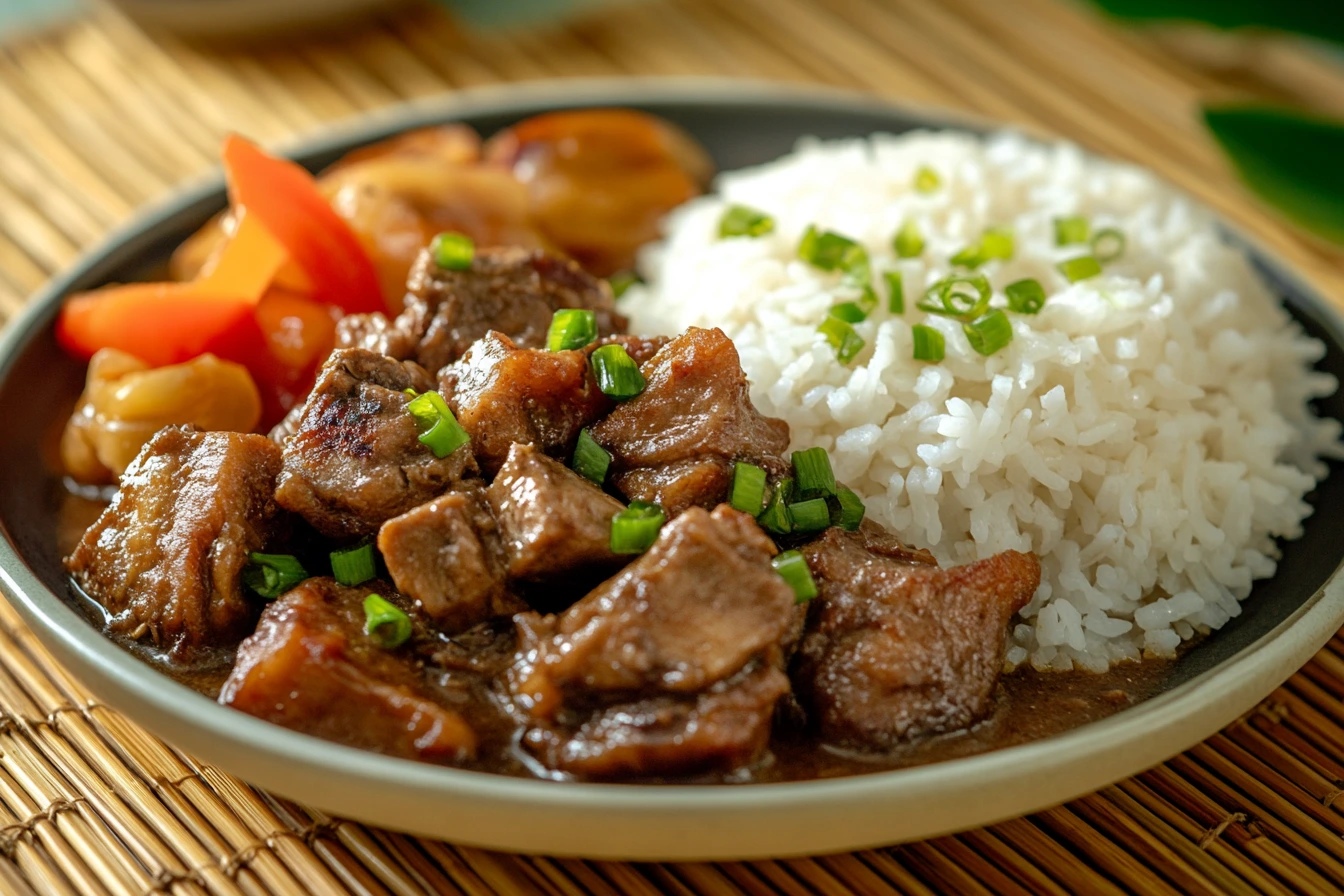Chicken adobo, a cherished Filipino dish, has captured hearts worldwide with its tangy, savory, and slightly sweet flavors. But there’s a curious question that food enthusiasts often ask: Is chicken adobo better the next day? Many believe its taste deepens, becoming richer and more delicious after resting overnight. In this article, we’ll dive deep into the flavors of chicken adobo, uncover the science behind its overnight magic, and explore tips for perfecting it.
Understanding Chicken Adobo
What is Chicken Adobo?
Chicken adobo is a traditional Filipino dish that blends simplicity and depth. The term “adobo” originates from the Spanish word for “marinade” or “seasoning,” but this dish has evolved into a distinctly Filipino creation. Its base ingredients—soy sauce, vinegar, garlic, bay leaves, and peppercorns—create a harmony of flavors that’s both comforting and bold.
This dish traces its roots back to pre-colonial times when Filipinos used vinegar as a natural preservative. Over the centuries, it has become a cultural icon, with families across the Philippines adding their unique twists to the recipe.
Why Do People Love Chicken Adobo?
There’s no denying that chicken adobo is a crowd-pleaser. Its complex flavor profile—a balance of salty, tangy, and slightly sweet notes—makes it incredibly versatile. You can pair it with steaming white rice, crusty bread, or even noodles.
Moreover, it’s easy to prepare. With just a handful of pantry staples and some patience, you can create a dish that feels like a warm hug on a plate. Its ability to taste even better the next day only adds to its charm, making it a top choice for leftovers.
Would you like to savor the essence of Filipino cuisine? Chicken adobo’s status as a comfort food in Filipino households is unmatched, symbolizing tradition, love, and home.
The Science Behind Flavor Enhancement
How Flavors Develop Overnight
The idea that some dishes taste better the next day isn’t just an old wives’ tale—it’s backed by science. When chicken adobo is left to rest, its flavors meld together, creating a richer and more harmonious taste. This is thanks to the Maillard reaction, a chemical process where proteins and sugars break down, enhancing the dish’s umami and depth.
The acidic vinegar, a hallmark of adobo, tenderizes the chicken while infusing it with its tangy kick. Meanwhile, the soy sauce penetrates the meat, imparting its salty savoriness. Garlic and bay leaves add subtle earthy undertones, which bloom as the dish rests. Over time, these flavors intermingle, making the dish taste balanced and robust.
Other stews and braised dishes, like curry or chili, undergo similar transformations when given time to rest. Chicken adobo, with its perfectly balanced ingredients, excels at this flavor enhancement.
What Happens to Chicken Adobo When Refrigerated?
Refrigeration doesn’t just preserve food—it can improve its texture and taste. When chicken adobo cools, the fat in the sauce solidifies slightly, locking in flavors. This process enhances the dish’s richness, as reheating releases the trapped aromas and oils.
However, it’s essential to store chicken adobo properly. To keep freshness and stop moisture loss, use airtight containers. For best results, avoid leaving the dish uncovered in the fridge, as exposure to air can dull its vibrant flavors.
Reheated chicken adobo feels like a warm, flavorful embrace, proving why it’s often considered better the next day.
Cooking and Storage Tips for Next-Day Perfection
Cooking Techniques for Better Next-Day Adobo
To make chicken adobo that truly shines on the second day, it’s all about the cooking process. Slow cooking is key—low heat allows the chicken to absorb the rich flavors of the sauce without drying out. Simmering also helps the garlic and bay leaves release their full aromatic potential, blending seamlessly with the soy sauce and vinegar.
Opt for bone-in chicken whenever possible. Bones add depth to the dish by releasing natural flavors during the cooking process. Plus, the meat stays juicier, making it a delight to reheat.
When adjusting the seasoning, it’s wise to lean on the lighter side. The flavors will intensify overnight, so what may taste perfect on day one could feel overpowering the next day. A touch of sugar can balance the acidity of the vinegar if needed, but avoid over-sweetening—it’s about balance, not dessert.
For an extra layer of flavor, some variations of adobo include adding hard-boiled eggs or vegetables like potatoes and carrots. While not traditional, these additions soak up the sauce beautifully and enhance the next-day experience.
How to Store Chicken Adobo Properly
Proper storage ensures that your chicken adobo remains as delicious on day two as it was when freshly made. Allow the dish to cool before transferring it to storage containers—this prevents condensation from watering down the sauce.
Use airtight containers to seal in the flavors. Glass containers are ideal as they don’t absorb odors, but BPA-free plastic options work well, too. Place the container in the fridge immediately after cooling; leaving it at room temperature for too long can invite bacteria.
When it’s time to reheat, avoid using a microwave if you can. Stovetop reheating on low heat is the best way to revive chicken adobo, as it warms the dish evenly and prevents the chicken from drying out. Stir occasionally to ensure the sauce doesn’t stick to the pot, and add a splash of water if the sauce has thickened too much in the fridge.
For longer storage, chicken adobo freezes exceptionally well. Simply portion it out into freezer-safe containers, label them with the date, and store them for up to three months. When ready to enjoy, thaw in the fridge overnight before reheating.

Is It Truly Better the Next Day?
Taste Test: Fresh vs. Next-Day Adobo
The age-old question—is chicken adobo better the next day?—often sparks lively debates among food lovers. To settle it, let’s explore the differences between fresh and next-day adobo.
Freshly cooked chicken adobo is undeniably delicious, with its vibrant, tangy sauce and tender chicken. However, some claim that the boldness of the vinegar can overshadow other flavors when eaten immediately. In contrast, next-day adobo offers a more balanced experience. The sauce thickens slightly as it rests, creating a velvety texture that clings to the chicken. The spices and seasonings mellow, giving the dish a deeper and more cohesive taste.
Food enthusiasts and chefs alike often note that next-day adobo is richer, as the marinade continues to work its magic overnight. But there’s a caveat—personal preference plays a significant role. Some prefer the punchy flavors of freshly cooked adobo, while others enjoy the nuanced, slow-built harmony of next-day adobo.
What Culinary Experts Say About Chicken Adobo
Filipino chefs and culinary experts widely agree that chicken adobo benefits from resting. Renowned chefs have remarked on the unique quality of braised dishes like adobo, which only improve with time. This phenomenon isn’t exclusive to Filipino cuisine—it’s a hallmark of stews and slow-cooked dishes worldwide.
The key lies in the ingredients. Vinegar, an integral component of adobo, continues to tenderize the chicken long after cooking. Garlic and bay leaves release oils that enrich the sauce, while soy sauce deepens the umami profile. This chemical symphony results in a dish that feels comforting yet refined.
Interestingly, this characteristic makes chicken adobo an excellent dish for meal prep or large gatherings. It’s not just convenient—it’s better! When asked why adobo stands out among other Filipino dishes, culinary experts often highlight its enduring appeal and ability to “age” gracefully in the fridge.
Common Variations of Chicken Adobo
Regional Twists on Chicken Adobo
Chicken adobo is a canvas for creativity, with regional and familial variations showcasing the versatility of this iconic dish. Across the Philippines, home cooks add their unique twists to adapt adobo to local ingredients and tastes.
One popular version is Adobo sa Gata, which incorporates coconut milk into the recipe. The creamy addition softens the sharp tang of the vinegar and adds a luscious richness to the dish. This variation is particularly loved in the Bicol region, known for its use of coconut-based dishes.
Another notable variation is Adobo sa Atsuete, which uses annatto seeds to impart a reddish hue to the dish. This version has a slightly earthy flavor and is a favorite in parts of Central Luzon.
For spice enthusiasts, Spicy Adobo delivers a fiery kick with the addition of chili peppers. Meanwhile, sweeter versions, popular in some Visayan islands, incorporate pineapple chunks or a touch of honey to balance the tangy base.
Regardless of the variation, the core flavors of adobo—savory, tangy, and aromatic—remain intact, proving its adaptability without compromising its essence.

Pairing Chicken Adobo with Sides
The beauty of chicken adobo lies in its ability to pair well with a variety of sides, elevating the dining experience. The most common accompaniment is plain white rice, which absorbs the flavorful sauce and balances its boldness. For a healthier twist, you can opt for brown rice or quinoa.
Pickled vegetables, known locally as achara, provide a bright contrast to adobo’s richness. Their tangy crunch cuts through the savory sauce, offering a refreshing bite. Another excellent pairing is garlic fried rice (sinangag), which enhances the dish’s garlicky notes and transforms leftovers into a hearty meal.
For a more complete spread, serve chicken adobo with sautéed greens or roasted root vegetables. These sides add texture and color to the plate, making the meal both visually appealing and nutritionally balanced.
Chicken adobo’s versatility extends beyond the main course—it can also shine in sandwiches or wraps, layered with fresh greens and a drizzle of its savory sauce. Whether paired with traditional sides or reinvented in modern ways, chicken adobo remains a dish that adapts to any occasion.
FAQs About Chicken Adobo
Why does chicken adobo taste better the next day?
Chicken adobo’s flavor improves overnight due to the mingling of its ingredients. As the dish rests, the vinegar, soy sauce, garlic, and spices continue to meld, creating a more cohesive and balanced flavor profile. The proteins in the chicken absorb the marinade more deeply, enhancing the taste with every bite.
How long can chicken adobo last in the fridge?
Properly stored in an airtight container, it can last up to four days in the refrigerator. Its vinegar and soy sauce base act as natural preservatives, keeping the dish safe to consume for several days. However, for the best taste and texture, it’s recommended to eat it within three days.
Can chicken adobo be frozen?
Yes, chicken adobo freezes exceptionally well. Divide it into meal-sized portions and store them in freezer-safe containers for up to three months. When you’re ready to enjoy, thaw it overnight in the fridge and reheat gently on the stovetop for the best results.
What’s the best way to reheat chicken adobo?
The stovetop is the ideal method for reheating chicken adobo. Use low to medium heat to warm the dish evenly, stirring occasionally to prevent sticking. If the sauce has thickened in the fridge, add a splash of water to restore its consistency. Compared to microwaving, this approach retains the dish’s flavor and texture better.
Is next-day chicken adobo healthier?
Nutritionally, next-day it’s remains the same as when it’s freshly cooked. However, some might argue that it feels lighter on the palate as the flavors mellow overnight, reducing the need to add more salt or seasoning when reheating.
Does beef or pork adobo have similar results when reheated?
Yes, other types of adobo, such as pork or beef, also benefit from resting overnight. The principle of flavor melding applies to these variations as well, with the rich, fatty cuts used in pork or beef adobo enhancing the taste even further when reheated.
Conclusion
Final Thoughts: Is Chicken Adobo Better the Next Day?
The allure of chicken adobo lies not just in its delectable flavor but also in its ability to transform over time. When enjoyed fresh, it offers a bold, tangy taste that’s undeniably satisfying. Yet, when left to rest overnight, it evolves into something extraordinary—its flavors deepen, its sauce thickens, and the dish becomes more harmonious.
This transformation is a testament to the power of patience in cooking. Whether you’re preparing a classic version or experimenting with regional twists, chicken adobo proves that good food doesn’t have to be complicated. And sometimes, letting a dish sit for a day can make all the difference.
So, the next time you make chicken adobo, consider setting some aside for the following day. You might just find that the wait was worth it, as this humble dish continues to surprise and delight with every reheated bite.

